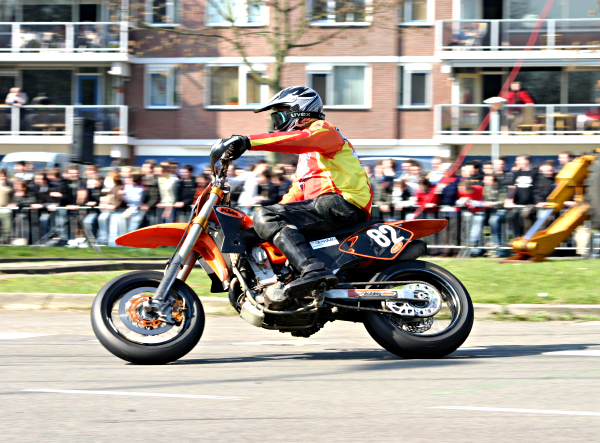Archive for March, 2007
TU/e Fast event at Eindhoven
Update: Additional photographs can be found at my new gallery.
Yesterday there was an event at Eindhoven, called TU/e Fast. This event consists of demonstrations of several fast vehicles, such as motorbikes, drag race cars and rally cars. It was organised by the European Week Eindhoven committee. My girlfriend is chief editor of the newsletter which is published every day during the European Week Eindhoven (which is this week). So, I was allowed to take photo’s from positions where regular public was not allowed.
Unfortunately, I do not have a very fast camera nor a very good lens. I’ve used my Canon EOS 300D (Digital Rebel) with an Sigma 70-300mm F4-5.6 APO. I think I took some nice pictures, but I’ve already seen better pictures from others. Oh, well… I’m still learning I guess.
Below I have a photo of a supermoto bike and a Lamborghini Gallardo. More pictures can be found in this TU/e Fast set on Flickr. I have lots of more pictures, which I will upload soon (at least a selection of it).
Kick-off event NIRICT
Last thursday, I visited the kick-off conference of the new Netherlands Institute for Research on ICT (NIRICT). This new research institute is founded by the three technical universities in the Netherlands: Eindhoven University of Technology, Delft University of Technology and University of Twente. The aim of the new organisation is to merge research efforts of the three universities. Compared to international research organizations, the Dutch universities are rather small. For example, the Eindhoven University only has approximately 7500 studens. Together, the NIRICT has 1200 full time researches and a budget of 75 million euro.
During the kick-off conference, the various research goals were presented and the Centre of Dependable ICT was officially founded. This Centre of Excellence will research technologies which improve the relability of software. There were several lectures at the conference, one of them by Dave Parnas from the University of Limerick (Ireland). He claimed that documentation on software is a neglected topic in ICT research.
I wrote a report of the conference in Dutch for Tweakers.net.
PS. This is the first weblog entry I wrote using Gnome-blog. It seems to work!
Open source photography
For people who think the only solution to have decent photo editing software, is to use a pirated version of Adobe Photoshop or Painshop Pro, there is a site called ‘Open Source Photography’. The site is all about (digital) photography and processing photographs using open source software. It contains tutorials on The Gimp, Illustrator and other software and provides information on other tools. The site focus on users, and I think this kind of initiatives makes open source software more accessible to common people.
Fixed images
Today, I fixed the images on my weblog of past articles. Because I moved my weblog to another subdomain, all links to pictures were invalid, resulting in no pictures at all on my weblog. Now, I simple created a symlink from the old location of my pictures to the new one, and that seems to work. While doing this, I also discouvered that it was possible to brows the directories on my webserver, which is a small security issue. Obviously, I fixed that as well.
Amersfoort
Last Saturday, I had to go to Amersfoort. Because I was a little earlier than planned, I took the opportunity to take some pictures (it was very nice weather). Below is a picture of the railway station, where one of the electronic notice boards can be seen. The NS is experimenting with these boards in order to replace the old-fashioned signs that are currently used on most railway stations. I think it is an improvement on readability.

WordPress source compromised
It seems that the source code package of WordPress 2.1.1 was compromised by a hacker. Some files, mainly related to RSS-feed generation, was injected with code which opens a backdoor. Obviously, this caused a large number of weblogs vulnerable. The cracker got user-level access to the download server of WordPress, and changes the download of version 2.1.1. The subversion repository wasn’t compromised, and also older versions weren’t. So if you’re using version 2.1.1, you should upgrade to version 2.1.2. Not all downloads of 2.1.1 are vulnerable, but the developers are not sure when the crach has happened.
This made me wonder why they don’t provide md5 sums for the download package. That way, it could be detected much earlier that the download was compromised. In the discussion on the mailing list, nobody came up with this idea.
Power supply
As I may have mentioned earlier on my weblog, the power supply of my server died a few weeks ago. The part was only four months old, so it was covered under warranty. I sent it to the shop where I bought the thing (Alternate) and got a replacement power supply in about two weeks. Unfortunately, they required to include all the accessories with the power supply. Because I bought the PSU along with a casing for my server, I wasn’t sure which accessories belong to the PSU, and which were part of the casing. So, I included a 24-pins-to-20-pins converter for connecting the PSU to older mainboards. That turned out to be a mistake, because that part didn’t belong to the PSU and the new PSU I received didn’t include such a converter. That was a bit of a problem, because I needed such a thing. Shops generally account 5 to 10 euro for such a small thing (it is only a few wires with two connectors…). I decided to sent a e-mail explaining the situation, and two days later I got a new converter in the mail, for free. That’s good service if you ask me.
Html parser for Java
For my graduation project, I needed to parse HTML documents, in order to strip the HTML tags and formatting (I wanted to index them using Lucene). After some searching on the Internet, I decided to use the library HTMLParser. This is a HTML parser developed in Java and the codebase seems to rather stable. It is not fully standard compliant, but that was not required for my purpose. However, it supports HTML documents which are not nicely formatted (missing end-tags, improper nesting, etc.). However, I stumbled upon a bug causing incorrectly parsing websites when they containg multiple META-tags defining the charset (using http-equiv="Concent-Type" META-tags). While this is not allowed according to the HTML specification, there are sites on the internet doing this. When downloading a website using HTTP, it is also possible to define the charset using HTTP headers. Changing the charset using META-tags generally should only be done when it is not possible to control the HTTP headers (because it is not possible to change the web server configuration, for example). The HTTPparser project handles changes of the charset by throwing an exception after which the document can be parsed again using the correct charset. However, this changing can be done infinitely when there are multiple charset definitions in a particular HTML document.
I’ve created a patch which fixes this problem. The good news is that the patch is accepted for the 2.0-version of HTMLParser, but I’ve also created a patch for the (older) 1.6-version (I’m using this version myself).
On another news: I’ve restored the archive of my weblog. It now goes back to the very beginning of my weblogging career. Unfortunately, there are some issues with encoding (probably a MySQL problem) and all the images on my weblog are broken.
You are currently browsing the Martin @ Blog blog archives for March, 2007.


